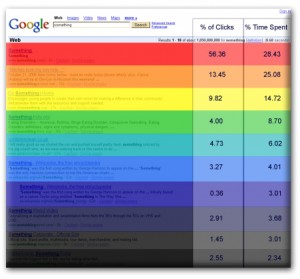
I often tell people interested in search engine optimization (SEO) that the trick is to think of search engines like they’re blind five year olds. Not only does this get people’s attention (and quick) but it helps to guide and simplify many SEO decisions.
Search engines don’t care if your site is pretty. They are essentially blind and can’t rate your site based on a gorgeous color palette, stunning photos or thrilling Flash animation. I’m not saying the site shouldn’t look good, but that isn’t going to help your SEO efforts, and in some cases it will actually hurt them.
You do need to tell search engines exactly what a page is about (a couple of times) and where to go next. In short, search engines are easily distracted. Sound a bit like a five year old?
Search engines are attempting to emulate our own evaluations of a site or page. The search algorithm is a form of artificial intelligence. I’m not an AI expert, but reaching the level of a five year old for such a complex task is quite a success. So please don’t misinterpret this as a swipe at search engines.
Words are of great importance to search engines. It’s one of the easiest ways it can categorize a page. But it is not reading the page like you or I. A search engine wouldn’t score well on a reading comprehension test. Instead it’s trying to understand the page by what words are most prominent, based on the number of times a word is mentioned and the size and placement of those words.
This is, in part, how a five year old is going to categorize something they’re reading. Repetition, as any parent can attest, is essential to a child’s comprehension. Green Eggs and Ham anyone?

Repetition is good for adults too. An old public speaking adage states that you need to repeat yourself at least three times since only a third of your audience is listening at any given time. In fact, most of the blind five year old principles will also help ‘real’ users better understand your site and content.
It becomes easy to come up with blind five year old examples once you embrace the idea.
A five year old will pay more attention to the title of a book and the synopsis mom or dad provides prior to reading. Done appropriately, these things provide the child an easy context. A search engine wants the same thing and craves a concise page title and seeks to compile a compelling snippet.
Search engines, like five year olds, will gravitate towards words that are bigger on the page or in bold. They’ll be equated with having greater value to the page than the smaller words. (Suspension of the blind portion of the principle is necessary here.)
Five year olds and search engines rarely understand wit or irony. That clever double-entendre you’ve used for your most recent blog post will only confuse the search engine. Use your wit, but use it judiciously and in the right places.
Give your five year old consistent easy to follow directions if you want them to get to a desired destination. Likewise, for best results, give a search engine consistent site navigation that is easy to follow.
A blind five year old will need detailed descriptions of any photos. A search engine is no different. IMG_001.JPG isn’t going to cut it.
A five year old can also, instinctively, determine if you’re ‘good’ or ‘bad’. You might fool a child with a ‘got your nose’ prank a few times, but deep down they’ve got your number. So don’t go off and try a bunch of black hat techniques in an effort to game the algorithm.
I could go on, but I think you get the point. While not all SEO techniques fit this model, blind five year old principles are the foundation of SEO and make your site and content easier to understand.










